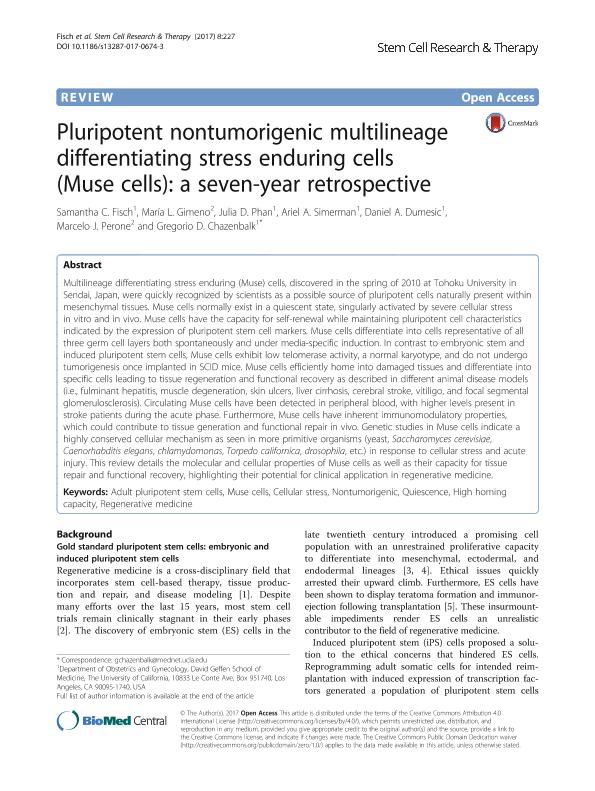Artículo
Pluripotent nontumorigenic multilineage differentiating stress enduring cells (Muse cells): a seven-year retrospective
Fisch, Samantha C.; Gimeno, Maria Laura ; Phan, Julia D.; Simerman, Ariel A.; Dumesic, Daniel A.; Perone, Marcelo Javier
; Phan, Julia D.; Simerman, Ariel A.; Dumesic, Daniel A.; Perone, Marcelo Javier ; Chazenbalk, Gregorio D.
; Chazenbalk, Gregorio D.
 ; Phan, Julia D.; Simerman, Ariel A.; Dumesic, Daniel A.; Perone, Marcelo Javier
; Phan, Julia D.; Simerman, Ariel A.; Dumesic, Daniel A.; Perone, Marcelo Javier ; Chazenbalk, Gregorio D.
; Chazenbalk, Gregorio D.
Fecha de publicación:
18/10/2017
Editorial:
BioMed Central
Revista:
Stem Cell Research & Therapy
e-ISSN:
1757-6512
Idioma:
Inglés
Tipo de recurso:
Artículo publicado
Clasificación temática:
Resumen
Multilineage differentiating stress enduring (Muse) cells, discovered in the spring of 2010 at Tohoku University in Sendai, Japan, were quickly recognized by scientists as a possible source of pluripotent cells naturally present within mesenchymal tissues. Muse cells normally exist in a quiescent state, singularly activated by severe cellular stress in vitro and in vivo. Muse cells have the capacity for self-renewal while maintaining pluripotent cell characteristics indicated by the expression of pluripotent stem cell markers. Muse cells differentiate into cells representative of all three germ cell layers both spontaneously and under media-specific induction. In contrast to embryonic stem and induced pluripotent stem cells, Muse cells exhibit low telomerase activity, a normal karyotype, and do not undergo tumorigenesis once implanted in SCID mice. Muse cells efficiently home into damaged tissues and differentiate into specific cells leading to tissue regeneration and functional recovery as described in different animal disease models (i.e., fulminant hepatitis, muscle degeneration, skin ulcers, liver cirrhosis, cerebral stroke, vitiligo, and focal segmental glomerulosclerosis). Circulating Muse cells have been detected in peripheral blood, with higher levels present in stroke patients during the acute phase. Furthermore, Muse cells have inherent immunomodulatory properties, which could contribute to tissue generation and functional repair in vivo. Genetic studies in Muse cells indicate a highly conserved cellular mechanism as seen in more primitive organisms (yeast, Saccharomyces cerevisiae, Caenorhabditis elegans, chlamydomonas, Torpedo californica, drosophila, etc.) in response to cellular stress and acute injury. This review details the molecular and cellular properties of Muse cells as well as their capacity for tissue repair and functional recovery, highlighting their potential for clinical application in regenerative medicine.
Archivos asociados
Licencia
Identificadores
Colecciones
Articulos(IBIOBA - MPSP)
Articulos de INST. D/INV.EN BIOMED.DE BS AS-CONICET-INST. PARTNER SOCIEDAD MAX PLANCK
Articulos de INST. D/INV.EN BIOMED.DE BS AS-CONICET-INST. PARTNER SOCIEDAD MAX PLANCK
Citación
Fisch, Samantha C.; Gimeno, Maria Laura; Phan, Julia D.; Simerman, Ariel A.; Dumesic, Daniel A.; et al.; Pluripotent nontumorigenic multilineage differentiating stress enduring cells (Muse cells): a seven-year retrospective; BioMed Central; Stem Cell Research & Therapy; 8; 1; 18-10-2017; 227
Compartir
Altmétricas



